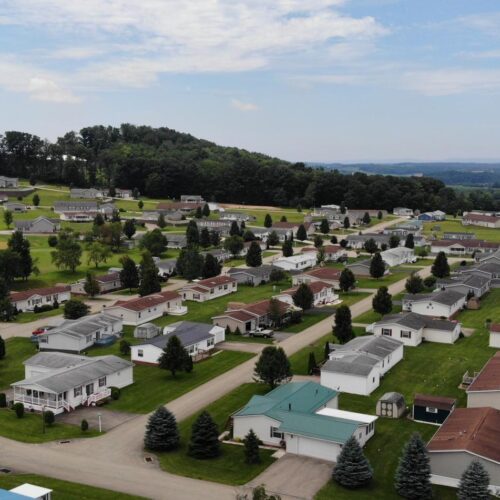Tackling the housing affordability crisis: Zoning reform in Maine

Courtesy of Canva
Five years ago, before the COVID-19 pandemic prompted a wave of new migration to Maine from states as far away as California, a housing crisis already loomed in the city of Auburn. A former mill town and manufacturing hub once known as “the shoe capital of the world,” the city of 26,000 residents had an aging population, stagnant growth, and major employers like Proctor and Gamble couldn’t find enough workers.
Auburn Mayor Jason Levesque, who was elected in 2017, took a hard look at the factors hindering young adults and families from putting down roots in the city, and it quickly became clear that they revolved around a lack of access to housing. Specifically, it was a crisis driven by outdated, restrictive, and in some cases, discriminatory zoning regulations.
“There’s a direct correlation between stagnation, degradation, and zoning,” Levesque said during a virtual discussion organized by CSG East on May 19.
Over the course of 2019, Levesque’s administration engaged residents in a citywide planning process, asking for input on how they would reimagine the city for growth and economic sustainability.
“There were 120 residents coming together and envisioning what they wanted the future of Auburn to look like,” Levesque said. “And it was really interesting because everything they wanted — walkability, things to do, entertainment — really needed people. So, we came to the conclusion that our biggest focus was to have people. And in order to have people, you need to have housing.”
In testimony before a state legislative panel last year, Levesque described new measures the city has implemented to transform the housing landscape, including:
- Eliminating single-family exclusionary housing zones;
- Enacting ordinances enabling accessory dwelling units (ADUs) anywhere in the city;
- Eliminating parking minimums;
- Increasing density by allowing developers to build 16 units per acre, up from a previous four, if sufficient infrastructure existed;
- Reducing the number of complicated residential zones from 32 to eight;
- Identifying prime development areas;
- Providing grants for energy efficiency;
- Eliminating 40 percent of permitting fees; and
- Simplifying the process for rehabilitating existing buildings or developing new housing, including creating a flat, $25 filing fee for new home construction.
Levesque said that by removing zoning barriers, the city of Auburn hopes to make it as easy as possible to build. Municipal staff will guide individuals through the process of building a single-family home, or duplexes, triplexes, and fourplexes, which are all now legal in the city. Over the last two years, more than 800 new market-rate housing units have been built in the city or are in various stages of the planning process, thanks to the reforms they have implemented.
“I can’t stress this enough: It’s about the individual. We believe people will solve the housing crisis if given the tools and the ability to do so,” said Levesque.
A population influx
In a sense, Auburn’s efforts were prescient. Over the last two years, Maine has experienced a net migration of 34,000 new residents, which is a significant influx to a state with a total population of 1.4 million. The majority of these new residents are under the age of 45, which adds to the state’s housing constraints, said former House Speaker Ryan Fecteau, who now serves as a senior advisor in the Maine Governor’s Office of Policy Innovation and the Future.
Home prices are rising: the state’s median home price jumped by 12 percent from 2021 to 2022, and anecdotal evidence suggests that prohibitive housing prices are making it impossible for some qualified workers to move there. In the city of Rockland, where the median price of a dwelling soared by 40 percent last year, the town hired a new police chief from out of state who was unable to find an affordable home – and ultimately, had to turn down the job.
“So this is not just an issue that’s impacting the private sector; it’s also impacting the public sector and our municipalities in terms of recruiting employees to work in education, public works and obviously, fire and police,” said Fecteau during the May 19 virtual discussion.
The state needs to build around 1,000 affordable housing units each year to meet demand, but until recently, annual construction only met a quarter of that need. In the last couple of years, however, new construction jumped to nearly 800 units in 2021 and just under 1,000 last year, spurred largely by new policies aimed at boosting development.
During his tenure as speaker, Fecteau made housing reform a priority. He established a commission that convened a wide range of stakeholders to consider how to reform zoning and land use to encourage more affordable development. The resulting legislation, enacted in 2022, included most of the municipal recommendations already adopted by the city of Auburn. The legislation established the following three key policies:
- A density bonus for affordable housing projects that meet certain income requirements.
- It enables up to four units of housing on any lot that is designated for residential use. The provision makes Maine the third state in the nation, after California and Oregon, that now allows building up to four units on lots that previously only permitted one single-family home.
- It reduces nearly all barriers to building accessory dwelling units across the state.
The law created a Housing Opportunity Fund that offers grants and technical assistance to municipalities to develop new policies and plans to increase the supply of housing.
Fecteau added that the legislation included certain restrictions to allay concerns about excessive sprawl. For example, additional density would be permitted only in areas deemed “growth areas” based on local comprehensive plans. In towns without comprehensive plans in place, new development would be limited to areas with adequate water and sewer infrastructure. “It’s about nuance, and I think we were able to strike that balance,” he said.
Leveraging federal funds
Prior to the passage of LD 2003, Fecteau helped to forge a number of incentives to stimulate new, affordable housing development.
In 2019, he sponsored legislation creating a low-income housing tax credit that enabled the state to leverage federal funds. The law provides $80 million over eight years for the creation of multifamily affordable housing available to residents earning up to 60 percent of the area median income. Last year, the state added another $25 million to the fund, and this year, Governor Janet Mills’ proposed budget contains an additional $35 million for the program.
Additional initiatives include:
- Rural Affordable Rental Program: Last year the state invested $20 million of federal American Rescue Plan funds in this new program, which is designed to build smaller projects, ranging from five to 18 rental units, that are intended to fit the character of rural communities. This year, Governor Mills’ budget proposes another $35 million for the program, which is available to residents making under 80 percent of the area median income.
- Innovation Fund for Attainable Housing: This is a proposed $10 million fund to create new programs around housing solutions.
- Housing First: Officials are also moving to establish a statewide initiative to tackle homelessness using the Housing First model, which has been implemented in cities and states across North America. The approach provides access to permanent housing for individuals and families without preconditions – such as treatment or sobriety requirements — and offers support services in an effort to ensure that people will stay housed. There are currently three sites that incorporate the Housing First policy, and officials are hoping to build 14 additional sites across the state with the goal of effectively ending chronic homelessness in Maine, said Fecteau.
Achieving the American dream
Getting public buy-in for a major zoning overhaul can be a contentious and emotional process, particularly among residents concerned that changing the design of their communities will diminish the value of their homes, which is typically a family’s largest source of wealth.
Fecteau admitted that while there was some pushback from groups who opposed the reforms set in motion by LD 2003, there was momentum for change across the state.
“There were probably twice as many people who were supportive of taking on this work because this is being felt in all our communities — people are struggling to find housing and employers are also struggling to find employees — so the timing was perfect.”
In Auburn, Levesque heard complaints from residents worried the reforms would change the “character” of their neighborhoods – a word that he interpreted as code for people of different socioeconomic and ethnic backgrounds. Levesque found this thinking to be so discriminatory that the city is in the process of stripping the word “character” from all of its zoning ordinances, starting with its comprehensive plan. The opposition comprised a group of “a couple dozen people at every meeting” who fought zoning changes that would allow apartments or accessory dwelling units in areas that had historically been zoned for single-family residences.
“Eventually, I just put them in a box and didn’t listen to them anymore because it all stemmed from one thing: They thought that success was finite and that the more people that achieved success through home ownership, through having a place to live, somehow diminished the amount of success that they and their family had,” said Levesque. “I found that immoral, and I told them that. Because growth is good, housing is good, the American dream is a reality — if we allow it to happen.”




